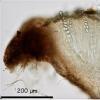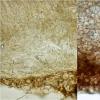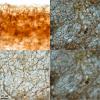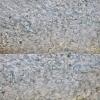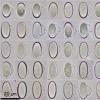
06-12-2025 00:19
 Viktorie Halasu
Viktorie Halasu
Hello, would anyone have this article, please? An

05-12-2025 17:33
 Bruno CouĂŠ
Bruno CouĂŠ
Bonjour, je serais heureux de recueillir votre avi

02-12-2025 18:59
This pair of ascos 2.5cm across were on recently b

02-12-2025 19:25
Buckwheat PeteHello, can anyone identify this hairy fungus growi

30-11-2025 12:53
 Edvin Johannesen
Edvin Johannesen
White short-stipitate apothecia found on thin twig

30-11-2025 10:47
 William Slosse
William Slosse
I recently found a collection of small Peziza sp.
 Apos < 5 mm, with a big "collarium" at the margin, on deer dungs, 24/11/2012.
Apos < 5 mm, with a big "collarium" at the margin, on deer dungs, 24/11/2012.Asci inamiloid, 8-spores, operculate, croziers Âż? I am not sure.
Thanks.

ça manque de prÊcision sur les dimensions des ÊlÊments micros et l'ornementation des spores

Paraphysis with many slightly strangulated septa and mixed with a "gloeocystidia-like" structure with many dots inside Âż?, with a red epithecium in IKI.
Spores (1000x, water)
(16.4) 17.0 - 18.2 (19.0) x (8.7) 9.2 - 10.0 (10.3) Âľm
Q = (1.7) 1.75 - 2.0 (2.1) ; N = 57
Me = 17.6 x 9.6 Âľm ; Qe = 1.8
Asci (400x, water)
(220.4) 221.7 - 237.0 (240.3) x (13.7) 14.5 - 18.7 (18.8) Âľm
N = 14;Â Me = 230.7 x 16.5 Âľm


Je suppose que tu as essayĂŠ de le comparer Ă P. cervaria
AmitiĂŠs et au plaisir de te revoir Ă Somiedo
Michel

I thought about P. cervaria, macro is more or less similar, but I did not see lateral and base hairs, it is completly smooth. This is the reason I doubt about the genus Pseudombrophila. But I suppose you are right, I have never seen it before.
Thanks.

http://www.asturnatura.com/fotografia/setas-hongos/pseudombrophila-theioleuca-rolland-1/3032.html
At Van Brummelen key, P. cervaria has reddish brown or brown disc and P. theioleuca hyaline or white. Mine is not white, but not reddish brown. And my asci have more than 200 Âľm long. Âż?
De par la prÊsence de pigments bruns entre le sommet des paraphyses, je pense qu'il peut en effet s'agir de P. cervaria (Phill.) Brumm. Je ne suis cependant pas sÝr que les ascospores prÊsentÊes (et mesurÊes ?) soient matures. A cela deux raisons: la prÊsence de granulations à l'intÊrieur (je ne parle pas du noyau qui est au centre) et le gÊlin qui entoure les ascospores, encore que certaines ascospores matures peuvent encore avoir encore du gÊlin. je remarque aussi que les ascospores sont plus larges que normalement chez cette espèce. Selon Brummelen 14,4-18,7 x 7, 9,9 ¾m (moyenne 16,6 x 8,8 ¾m). Je vous conseille de laisser encore maturer cette espèce et de refaire les mesures, sur sporÊe.
Proche de cette espèce il y a aussi P. theioleuca Rolland, qui croit aussi excrÊments de chevreuil, mais cette espèce ne prÊsente pas de pigments bruns entre les paraphyses.
Cordialement
RenĂŠ

I can not say that the spores were fully mature, but I can assure that are measured outside the asci and expelled them without any pressure. They were obtained from the cross sections of the apothecia, in water and mounted without any pressure, only the coverslip. During the observation of the cuts to make the pictures I remember seeing the expulsion of many spores.
Unfortunately the collection is November 2012 and the apothecia are already dry. Next time I collect it, I will wait more time to mature.
Thank you very much for your help.
Cordialement.
Miguel Ă. Ribes

